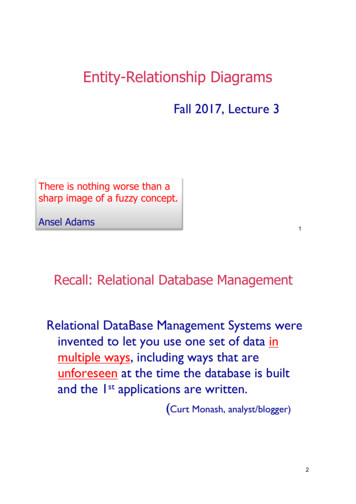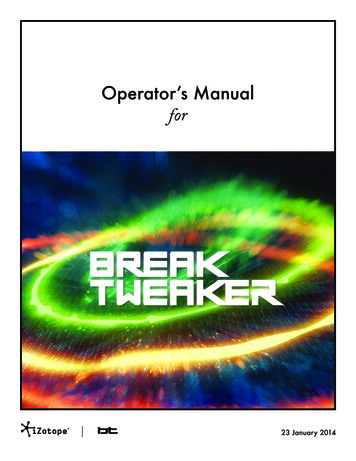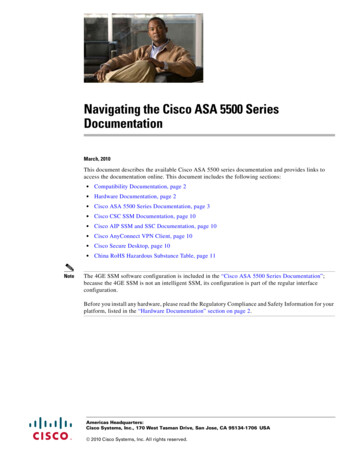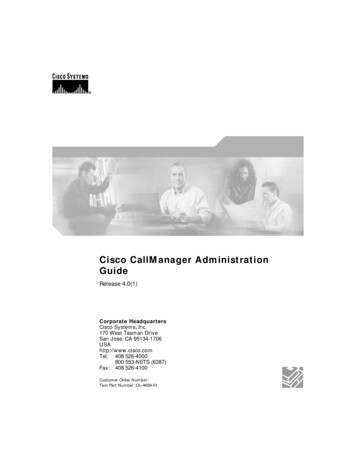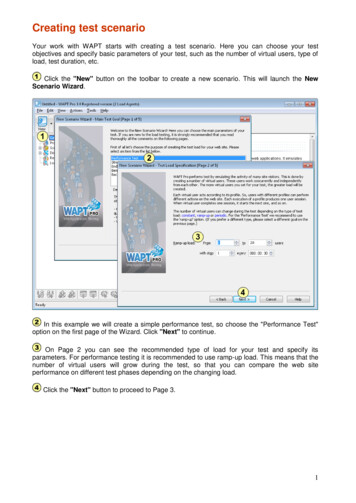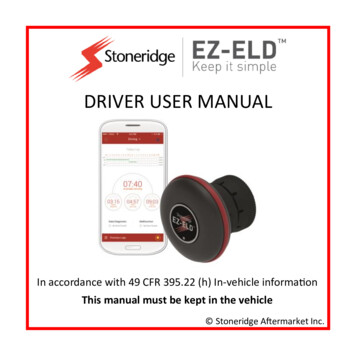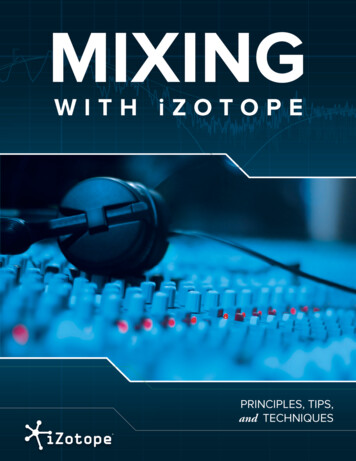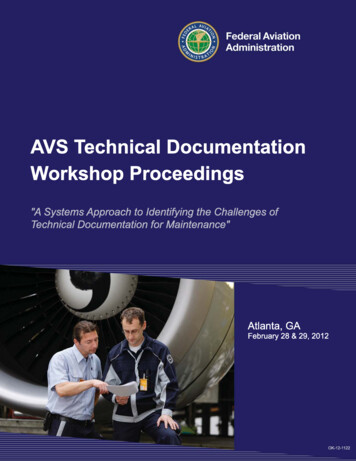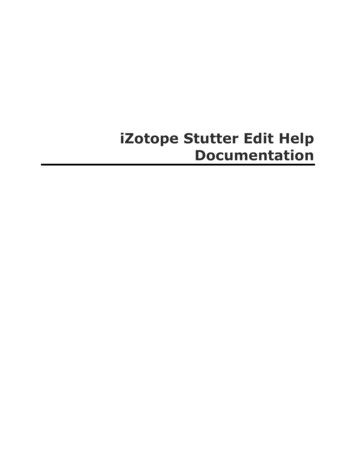
Transcription
iZotope Stutter Edit HelpDocumentation
Table of ContentsIntroduction . 1Welcome to iZotope Stutter Edit . 1iZotope Customer Support . 2Quick Start . 3First Steps . 3Ableton Live . 4Apple Logic . 8Avid Pro Tools . 11Cakewalk SONAR . 13Cockos Reaper . 17Image-Line FL Studio . 20MOTU Digital Performer . 25PreSonus Studio One . 27Steinberg Cubase/Nuendo . 29Playing Your Effects . 31Understanding The Basics . 31How Gestures Work . 32Global Gesture Settings. 35Basic Module Controls . 37Global Filter. 39Timeline Override . 40Presets . 41Simple Preset Loading and Saving . 41Preset Manager/Customizing Banks . 42Stutter Modules . 45Stutter Matrix . 45Stutter . 46Quantize . 47Buffer Position . 48Gate Width . 49Jump Pan . 50Color Effects. 51Stereo Delay . 51Delay Band-Pass . 52Low/High-Pass Filter . 53Bit Reduction . 54Lo-Fi . 55Gain . 56Generator . 57Generator Gesture Length . 57Noise Table and Gain . 58Pitch . 59Lo-Fi . 60Stutter Gate Send . 61Band-Pass Filter . 62Delay . 63Settings. 64Options . 64ii
IntroductionWelcome to iZotope Stutter EditThanks for using Stutter Edit!- the iZotope team 2001-2011 iZotope, Inc. All rights reserved. iZotope, iZotope.com, the iZotope logo, and Stutter Editare either registered trademarks or trademarks of iZotope, Inc. in the United States and/or other countries.V 1.0.1.4301
iZotope Stutter Edit Help Documentation1. INTRODUCTIONiZotope Customer SupportHow to purchase the full version of Stutter EditIf you are using the demo version of Stutter Edit and would like the full version, you canpurchase Stutter Edit direct from the iZotope online redit/Once your purchase is complete you will be sent an email confirmation and a full versionserial number that can be used to fully authorize your current installation of Stutter Edit.Customer Support PolicyiZotope is happy to provide professional technical support to all registered users absolutelyfree of charge. We also offer valuable pre-sales technical support to customers who may beinterested in purchasing an iZotope product. Before contacting iZotope support, you cansearch our Product Knowledgebase to see if the solution to your problem has already rHow to contact Technical SupportFor additional help with Stutter Edit, please check out the support pages on our web site athttp://www.izotope.com/support or contact our customer support department atsupport@izotope.com.iZotope's highly trained support team is committed to responding to all requests within one(1) business day and frequently respond faster. Please try to explain your problem with asmuch detail and clarity as possible. This will ensure our ability to solve your problemaccurately, the first time around. Please include all system specs and the build/version ofStutter Edit that you are using.Once your support request is submitted, you should automatically receive a confirmationemail from iZotope support. If you do not receive this email within a few minutes pleasecheck your spam folder and make sure our responses are not getting blocked. To preventthis from happening please add support@izotope.com to your list of allowed emailaddresses.2
Quick Start2. QUICK STARTFirst StepsPlease choose from one of the supported audio host applications below for specificinstructions on getting up and running with Stutter Edit:Ableton LiveApple LogicAvid Pro ToolsCakewalk SONARCockos RepearImage-Line FL StudioMOTU Digital PerformerPreSonus Studio OneSteinberg Cubase/NuendoJust want to hear some crazy sounds before you get all set up?To immediately audition Stutter Edit's Gestures on your audio without a MIDIcontroller, simply instantiate Stutter Edit on to an Audio Track in your host, andwhile your host's transport is playing back, click and hold on any of thekeyboard notes inside of Stutter Edit's Preset Manager window.3
iZotope Stutter Edit Help Documentation2. QUICK STARTAbleton Live1. Add Stutter Edit to either an individual Audio Track or to your Master Output.2. Create a MIDI track (Create Insert MIDI Track).4
Quick Start3. From the "MIDI From" drop down menu on your newly created MIDI track, choose theexternal controller you want to use to control Stutter Edit4. Set the Monitor selector on the MIDI track to "In" instead of "Auto"5
iZotope Stutter Edit Help Documentation5. From the "MIDI To" drop down, choose the track you have added Stutter Edit to.6. Mash some keys with audio playing back . there you go!6
Quick Start7
iZotope Stutter Edit Help Documentation2. QUICK STARTApple Logic1. Create an Audio, Software Instrument, or Aux track that you want to manipulate withStutter Edit.2. Next, create a new Software Instrument track.3. Instantiate "Stutter Edit" by clicking and holding on the Input for this new SoftwareInstrument track. Stutter will be available under "AU MIDI-Controlled Effects" from theInput effect menu.8
Quick Start4. In the upper right-hand corner of the effect window (in Logic's plug-in UI container),choose the audio path you want to apply Stutter Edit to from the Side Chain drop menu.5. Make sure the Instrument track is selected in order to route any incoming MIDIinformation to the Stutter Edit plug-in or click the "R" record button to record-enable yourincoming MIDI performance.9
iZotope Stutter Edit Help Documentation10
Quick Start2. QUICK STARTAvid Pro Tools1. Add Stutter Edit as an Insert plug-in onto any Track, Master Fader, or Bus. To do this,click an empty insert slot on the track's mixer channel, and find Stutter Edit in the "Effect"category.2. Create a new MIDI track in your project. Go to the "Track New" menu and choose MIDIfrom the drop down list that specifies the track type you're creating.3. On the Mixer channel for your new MIDI track, find the I/O section. Assign the Input tothe MIDI controller you want to use to control Stutter Edit.11
iZotope Stutter Edit Help Documentation4. Assign the Output of the MIDI channel to Stutter Edit. You will see Stutter Edit in the listif it is on any of your Pro Tools channels.5. You can now trigger Gestures from a MIDI controller routed through this channel, or byusing the Piano Roll editor in Pro Tools to manually add notes. Enjoy!12
Quick Start2. QUICK STARTCakewalk SONARIMPORTANTIn order to use Stutter Edit in SONAR and other Cakewalk hosts, you must loadthe VSTi version as an effect. If you do not do this, you will not be able tocontrol Stutter Edit from a MIDI track or controller.SONAR can only send MIDI information to VST plug-ins it classifies as an"Instrument" - so you need to tell SONAR to use Stutter Edit as an "Instrument"before you can use it on your tracks. After taking these steps, you'll be able tofind Stutter Edit listed under your "Soft Synths" rather than "Effects," but you'llbe able to add it as an insert effect to any track or bus.Configure Stutter Edit as a "Synth"1. After installing Stutter Edit, go to Cakewalk's Plug-in Manager (Tools Cakewalk Plug-inManager).2. Next, find Stutter Edit in the directory of VST plug-ins that are displayed and select it inthe list. (if you don't find it here, you may need to hit Scan VST Plug-ins first.13
iZotope Stutter Edit Help Documentation3. Under the "VST Configuration" controls, press the "Plug-in Properties" button.4. Make sure the "Configure as Synth" checkbox is selected.14
Quick StartAdd Stutter Edit to a Track or Bus5. Right click on the Effects Bin for the track or bus you want to add Stutter Edit to.6. Go to the Soft Synths category and select the Stutter Edit VST plug-in.7. Create a new MIDI track in your SONAR project.15
iZotope Stutter Edit Help Documentation8. On the MIDI track's output dropdown menu, choose Stutter Edit from the list.9. You can now trigger Stutter Edit gestures from the MIDI track or from a MIDI controllerthat SONAR is routing to this track. Enjoy!16
Quick Start2. QUICK STARTCockos Reaper1. Create a new Track (Track Insert New Track).2. Go to the FX button for the newly created Track, and choose "iZotope Stutter Edit" fromyour VST Plug-ins folder.3. Click the Arm button on your Stutter Edit Track in the track view and from the drop-downbox that appears over the meter, select the "MIDI Input" or controller you want to use toplay Stutter Edit.17
iZotope Stutter Edit Help Documentation4. Make sure the Input Monitoring (speaker icon button) is on so that MIDI will be sent fromyour controller to Stutter Edit. You can now trigger Stutter Edit gestures from an externalcontroller.OR:5. To sequence Stutter Edit without a controller, simply add a MIDI item to your Stutter Edittrack and enter notes with your cursor.18
Quick Start19
iZotope Stutter Edit Help Documentation2. QUICK STARTImage-Line FL Studio1. Go to The Mixer View.2. Add Stutter Edit (VST) to the Effects section of your Master channel or any individualchannel.20
Quick Start3. Open the plug-in Settings Menu (the gear icon) in the upper left hand corner of theStutter Edit plug-in window.4. In the MIDI box, choose any MIDI port that is not assigned to another device in fruityloops.21
iZotope Stutter Edit Help Documentation5. Now go to the menu (Channels Add One ) and select MIDI Out.22
Quick Start6. Open the Channel Settings for the MIDI Out you just created and assign it's port to thesame one you've chosen for Stutter Edit.7. You can now trigger Gestures from steps or piano roll events on this new MIDI Out track,or with a MIDI controller routed through this channel. Enjoy!23
iZotope Stutter Edit Help Documentation24
Quick Start2. QUICK STARTMOTU Digital PerformerIMPORTANTAfter following the steps below, Digital Performer requires that its transport berunning and playing back in order for Stutter Edit to switch gestures.Stutter Edit can only be loaded as an AudioUnit (AU) plug-in inside of DigitalPerformer.1. Instantiate Stutter Edit as an AudioUnit (AU) insert plug-in on any Audio track.25
iZotope Stutter Edit Help Documentation2. Insert a new MIDI track from the (Project Add Track) menu.3. Set the output of the MIDI track to "StutterEdit: track name : Insert .".26
Quick Start2. QUICK STARTPreSonus Studio One1. Instantiate Stutter Edit as an effect on any audio track.2. Create a blank Instrument track (you can label it "Stutter Edit Send" in order to keeptrack of the routing)3. Configure the input of the "Stutter Edit Send" track as your controller.27
iZotope Stutter Edit Help Documentation4. Configure the output of the "Stutter Edit Send" track as "Stutter Edit"28
Quick Start2. QUICK STARTSteinberg Cubase/Nuendo1. Instantiate Stutter Edit as an Insert plug-in effect onto any Audio track.2. Create a new MIDI track from the (Project Add Track) menu.3. Configure the input of the MIDI track as your controller.29
iZotope Stutter Edit Help Documentation4. Configure the output of the MIDI track as "iZotope Stutter Edit - Midi In".30
Playing Your Effects3. PLAYING YOUR EFFECTSUnderstanding The BasicsWhat is this thing?Stutter Edit is a real-time, playable effect. Unlike other effects, you control Stutter Edit via aMIDI controller (or your host program’s sequencer) to add variations, transitions, fills, andother ear candy to music and other audio.If this is your first time looking at Stutter Edit, you might feel like you just sat down at thehelm of an alien spacecraft! This effect works differently than ordinary plug-ins, so that’s anatural reaction. There is a lot to take in, but if you follow this Quick Start Guide, you’ll bemaking crazy new sounds in no time.To begin:1. Load Stutter Edit onto any track or bus in your host program of choice that willhandle or pass audio.Refer to Quick Start section for specific instructions on getting set up with Stutter Editin your supported host.2. Next, route a MIDI track in your host to the Stutter Edit plug-in or make sureStutter Edit is receiving MIDI from your MIDI controller. Stutter Edit needs to be“triggered” before you can hear it adding an effect.Some hosts including Ableton Live have a way of using your computer keyboard totrigger MIDI notes.3. Begin playback of your host application's transport in order to send some audiothrough the track or bus containing the Stutter Edit plug-in.4. Start playing some notes on your controller, or start painting notes into your MIDItrack in order to trigger and engage any of the Gestures for the currently loaded Bank.5. Explore and experiment with any of Stutter Edit's available Banks by using the"Bank" drop-down menu at the top of Stutter Edit's interface. You can use the Savebutton to the right of this menu in order to quickly Save any edited settings, or clickon the Preset Manager in order to launch the floating Manager window.6. Enjoy!31
iZotope Stutter Edit Help Documentation3. PLAYING YOUR EFFECTSHow Gestures Work“Look at all of those controls! It’s a lot to think about,” you might be saying to yourself.Well, to start, let’s stop thinking about it, and start thinking about Gestures.A Gesture is a set of effects that all live on a single MIDI note. Gestures are the key (yeahthat’s a pun) to making Stutter Edit such a musical and playable effect. A single press of akey or drum pad can do something simple, like replaying a chunk of audio at a certainrhythmic value, like an 1/8 note. Or it can trigger a run of incredibly complex stutters thatget decimated by a bit crusher before being filtered and then released into a wash ofechoes. Did we lose you yet?Well, here’s the important thing: Gestures condense all of these complex effects, and theirtimelines, onto a single key. Which makes it simple to play Stutter Edit, whether you’re onstage or in the studio. The best way to find good sounds is simply to experiment by loadingone of the included Bank presets and then playing or triggering different gestures. This willhelp you get your head around exactly what Stutter Edit does.Loading a BankGestures are combined into Banks, which are essentially Stutter Edit presets. When youload a single bank, it contains tons of Gestures already mapped to MIDI notes for you. Youcan also customize banks to your liking using the Preset Manager (more on this later).To choose one of the “factory” banks for Stutter Edit, just go to the Bank drop down list atthe top of the interface.TIP: When you’re ready to go a little deeper, you can also use the PresetManager to reorganize gestures any way you like. You can collect all of thegestures you want to use for a gig in a new bank, or put certain gestures oncertain keys as you refine your playing technique.Playing Gestures to Add Effects32
Playing Your EffectsWhen you put Stutter Edit on a track, or on your main mix, you can fire off Gestures byhitting notes on your favorite MIDI controller. If you prefer, you can also paint notes intoyour host’s MIDI sequencer (such as a piano roll view, or step sequencer) to make gestureshappen at particular moments.Note: When using Stutter Edit on musical material, it’s best to have your hostprogram set to the correct tempo for the music you’re playing back.Stutter Edit “listens” to the host for its tempo. When Stutter Edit is locked totempo, it’s almost impossible to do things that sound “wrong.”With a little experimentation, you’ll find that Gestures can: Add variation to repetitive loops or sections of a song Add musical filter sweeps over set a number of beats or measures Create delay effects that repeat over your track when you release a gesture Add build-ups and transitions with filtered noise sweeps Grunge-up your audio subtly or drastically with lo-fi effects And lots more!As you play some Gestures with your song or track playing back, you’ll start to get a feel forwhat all of the effects do. The best way to learn Stutter Edit is by experimenting with theBanks that come with it.TIP: Try to get out of the mentality of “I’m going to put this effect on the wholetrack.” Stutter Edit changes as you play different notes, which gives you a wholenew way to think about adding effects. Forget you have a mouse for a couple ofminutes. Let your ears guide you!Stutter Gestures and Generator GesturesWhen you play a key to activate a gesture, you’ll notice a light that tells you what type ofGesture it is.There are two types of Gestures: Stutter Gestures – these process audio with the Stutter effect as well as othercreative processors like Filters, Delay and Lo-Fi effects Generator Gestures – these gestures generate noise and other sounds on top of theaudio playing through Stutter Edit. They let you create rising build-ups and otherdynamic transitions.33
iZotope Stutter Edit Help DocumentationYou can only play one Stutter Gesture at a time, and one Generator Gesture at a time.HOWEVER you can play one of each at the same time. Generator Gestures can also feedtheir output into whatever Stutter Gesture you are playing via the Stutter Gate Send controlin the Generator Panel. This makes for some really mind-blowing effects. Try it!Note: If a key location is empty, you’ll see the Inactive light – to make thatlocation into either a Stutter or Generator gesture, simply click the Stutter orGenerator light.TIP: Try switching between a few Stutter gestures while you’re holding down aGenerator gesture key. This is a great way to create dynamic transitions thatsound like they were made in a studio with hours of careful editing andautomation! No one has to know you were only pressing two keys-- we promisewe won’t tell.Recording Your Effect Performance as MIDIIf you’re working in the studio, and want to capture the awesome combinations of gesturesyou’re playing, remember to record onto a MIDI track as you trigger gestures from yourcontroller. Your sequencer will capture your key presses and play them back for you. And ofcourse, if you want to change when gestures start, or swap between different ones, you cansimply move notes around with your host program’s MIDI piano roll editor just like youwould for a virtual instrument.Or, you might prefer to actually manually enter notes into your piano roll view, or a stepsequencer if your host provides one, to trigger Stutter Edit’s Gestures. This is also a goodway of working with Stutter Edit in a production setting.34
Playing Your Effects3. PLAYING YOUR EFFECTSGlobal Gesture SettingsOnce you’ve gotten a taste of what Stutter Edit can do, you’re probably going to want totweak how some of the gestures sound, or to make your own completely from scratch. Hereare a few helpful tips for doing just that.These Gesture Settings let you set up the way each individual gesture behaves and how itresponds when played.Gesture LengthThis control defines how long the current gesture is. Each Gesture can be set to coverdifferent ranges of time, from 16th notes (a quarter of one beat) up through 2 Bars ormeasures (8 beats). The Gesture Length determines the timeline for a gesture. That is, itdetermines how quickly the modules will sweep through the “Ranges” you set for each ofthem.GridThis setting ensures that you will always trigger gestures on exactly the right beat, even ifyour timing is a little off! Setting it to “1/8” means the gesture will always start exactly onthe next Eighth Note. You can set Stutter Edit to be more or less responsive depending onhow you play, and how you want each individual gesture to respond. (This is similar towhat some drum machines and sequencers call “Input Quantize”).Release ModeThis setting lets you set how the gesture will end. This can be useful for tailoring StutterEdit to your own playing style. Here is a quick description of each mode:On Grid - The gesture will end when you stop playing its MIDI note, but it will waituntil the next Grid point (1/8, 1/16 etc).Full Gesture - The entire gesture will play through from start to finish, even if youonly tap the note.Latch - The gesture will play and hold until you trigger it again (or trigger anothergesture).Instant - The gesture will end instantly when you stop playing its MIDI note.Stick - Similar to Latch mode, but the effect will “stick” at the end of the gesture’stimeline.TIP: Try assigning a Generator Gesture to Full Gesture release mode. This letsyou juggle a few Stutter Gestures without having to keep your finger on anotherkey!Palindrome Looping35
iZotope Stutter Edit Help DocumentationPalindrome Looping affects how gestures repeat or loop when they are held and notreleased.ON – the gesture’s timeline will reverse direction when it reaches the end of theGesture Length, creating an up and down or back and forth sweeping effect.OFF – the gesture’s timeline will start over when it reaches the Gesture Length.36
Playing Your Effects3. PLAYING YOUR EFFECTSBasic Module ControlsThere are a number of module controls that are used throughout Stutter Edit. If youunderstand how these basic module controls work, you’ll be able to find your way aroundeasily.Active ButtonThe active button selects whether a module will be active as a part of the current gesture.The Timeline DotWhen playing a gesture, you’ll see small dots moving across the sliders in Stutter Edit’smodules. This shows what each of the modules is doing in relation to the gesture’s timeline.All of Stutter Edit’s effects can change, in sync with your project, over the length of thegesture you’re playing.Range HandlesUse the Range Handles to set the range of values the Gesture will sweep through for eacheffect. By dragging one handle past the other you can change the direction the Timeline Dotmoves. You can make a gesture sweep either down or up over the length of thegesture. When both handles are touching, that means you have set a fixed value for thegesture. This is useful if you don’t want an effect to follow the gesture’s timeline, andinstead want it to stay at one setting the entire time the gesture is playing.Range Handle ShortcutsRight or Command-click on a range handle, you can choose from several options that helpyou quickly edit settings:Locked - locks the handles at their current location letting you move a "range" aroundthe slider without moving one handle then the otherLock at Value - locks both handles together at the position of your cursor, letting youset the slider to one value that doesn't change during the gesture37
iZotope Stutter Edit Help DocumentationFlip Range – Flips the position of the range handles, allowing you to quickly make thetimeline move in the opposite direction for the current moduleFull Range - Sets the range handles to the edges of the rangeNote: Double clicking will also link the Range Handles together. This makes iteasier to move them at the same time.Curve ControlThe Curve Control slider changes the way the Timeline Dot moves across the range you’veset for an effect. In the center of the slider’s range, the curve is linear— that is, the Timeline Dot willmove at the same rate from start to finish. At the far left, the curve is a fast, or logarithmic, curve. The timeline dot will movemore quickly at the start of the gesture, but then will slowly approach the end of therange. At the far right, the curve is set to a slow, or exponential, curve. The Timeline Dotwill move slowly when the gesture is first triggered, and will quickly approach the endof the range more slowly near the end of the gesture.38
Playing Your Effects3. PLAYING YOUR EFFECTSGlobal FilterThe global filter is a combination low-pass, high-pass filter. In it’s center, off position, itdoes not filter the signal. Moving it downward engages a low-pass filter, moving it upengages a high-pass filter.It can be used to shape the overall sound of Stutter Edit. While the Filter Modules in StutterEdit are designed to be automated on a timeline, the Global Filter is meant to bemanipulated by hand.By default the Global Filter is assigned to the MIDI Pitch Wheel parameter. This can beuseful because the Pitch Wheel will automatically spring back to center on most controllers,allowing you to let go of it when you want the filter to go back to it’s Off position.You can also re-assign the Global Filter to other MIDI control parameters. Go tothe Options menu (gear icon) to assign MIDI input to the Global Filter.39
iZotope Stutter Edit Help Documentation3. PLAYING YOUR EFFECTSTimeline OverrideWhen a Gesture is triggered and engaged by an incoming MIDI note, each of Stutter Edit'smodules or effects will begin to sweep through the defined ranges and curve controlsettings. This is represented visually by the small timeline dots sweeping in between eachmodule's range handles and is calculated based on your host applications tempo.In order to control the movement of this timeline however, you can use the TimelineOverride Control and link this global timeline to any incoming MIDI Continuous Controller.What results is a control that allows you to control the position of each engaged effect withrespect to their defined range. In this way, you can control sweeps, create special FX orprovide very gradual Gesture Lengths beyond the available "Two Bars" in Stutter Edit'sGesture Length drop down menu.40
Presets4. PRESETSSimple Preset Loading and SavingIn Stutter Edit, each Bank is a Preset, containing multiple "Ge
Ableton Live Apple Logic Avid Pro Tools Cakewalk SONAR Cockos Repear Image-Line FL Studio MOTU Digital Performer PreSonus Studio One Steinberg Cubase/Nuendo while your host's transport is pl Just want to hear some crazy sounds before you get all set up? To immediately audition Stutter Edit's Gestures on your audio without a MIDI

